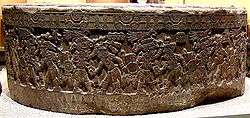Stone of Tizoc
|
{{{caption}}} | |
| Created | 1480s |
|---|---|
| Discovered | 17 December 1791 |
| Present location | National Museum of Anthropology, Mexico City |
The Stone of Tizoc, Tizoc Stone or Sacrificial Stone is a large, round, carved Aztec stone, rediscovered on 17 December 1791. It is thought to have been a quauhxicalli, in which the hearts of victims of sacrifice were placed.
The stone is made of basalt and measures .88 meters deep by 2.67 meters wide.
The stone depicts Texcatlipoca, a major Aztec god, holding the patron gods of other places by the hair. Aztec glyphs give the name of the original site, which may have already been conquered, or was considered divinely ordained to be conquered. The toponyms are written in a mixture of logographic and syllabic signs. One of the figures, however, is identified as Tizoc, the Aztec Emperor from 1481 to 1486, who is dressed in the costume of the god Huitzilopochtli and named with his name glyph. This has led to the stone's association with Tizoc. The stone also depicts the stars at the top rim, emphasizing the heavens; triangular points at the bottom edge represent the earth. The warriors carved into the stone are holding the hair of their enemies gods, a gesture which represented submission and defeat in the Aztec culture.
The Stone of Tizoc may have been used as a means of sacrifice or for the use of mock battles between a group of warriors and the victim, who was tied to the stone and given a feathery club while the warriors had sharp swords or clubs. The importance of the Stone of Tizoc is that it was used during the human sacrifices, which Tizoc the emperor wanted glorified through his name. Also, the emperor of the Aztecs would tend to conceive his children on this rock, soaking in the blood of his enemies.

Tizoc was the seventh emperor of the Tenochtitlán empire after his brother, Axayacatl, died in 1481. The Stone depicts Tizoc's image all over the stone; this was a way to glorify Tizoc's reign despite the many failed battles and military strategies. The Stone of Tizoc has become a staple of Aztec history along with the Aztec Calendar Stone. The Aztec sacrifice was held at the top of temples on specially chosen mountains such as Tenochtitlan, Texcoco, and Tlacopan in which priests had the victims tied to a large, flat stone and then proceeded to cut their hearts out, lifting it up to the sun as an offering. The bodies were either thrown down the temple stairs or the heads were impaled on a rack, also known as a tzompantli.
Sacrifices had begun in the Aztec culture as a form of worship to the gods that demanded payment for creating humanity. The capital of the Aztecs, Tenochtitlan, held thousands of sacrifices which involved men, women, and children.
Sacrifices were held to honor the gods such as: Huitzilopochtli, the god of sacrifice and war, Tlaloc, the god of rain and fertility, Tezcatlipoca, the chief god of the Aztecs, and Quetzalcoatl, the god of education, priesthood, and civilization.
The stone is currently in the National Museum of Anthropology in Mexico City.
Bibliography
- Orzco y Berra, Manuel (1877). "El cuauhxicalli de Tizoc". Anales del Museo Nacional de México (in Spanish). 1: 3–39.
- Umberger, Emily (2008). "Ethnicity and Other Identities in the Sculptures of Tenochtitlan". Ethnic Identity in Nahua Mesoamerica: The View from Archaeology, Art History, Ethnohistory, and Contemporary Ethnography. Salt Lake City: University of Utah Press. pp. 64–104. ISBN 978-0-87480-917-6. OCLC 173182658.
- Wicke, Charles (1976). "Once More Around the Tizoc Stone: A Reconsideration". Actas del XLI Congreso Internacional de Americanistas, México, 2 al 7 de septiembre de 1974. Mexico City: Comisión de Publicación de las Actas y Memorias. pp. vol. 2, pp. 209–222.
- Cartwright, Mark. "Aztec Sacrifice". Ancient History Encyclopedia. Retrieved 13 December 2013.
- Van Tuerenhout, Dirk R. (2005). "Chapter 8. Religion and ideology". The Aztecs. New Perspectives. Santa Barbara, California: ABC-CLIO. ISBN 978-1-57607-921-8.
- "Aztec". Religion. Aztec Systems Corp. Retrieved 16 December 2013.
- VanEssendelft, Willem (2011). The Word Made Stone: Deciphering and mapping the glyphs of the Tizoc stone (PDF). Masters thesis. Harvard Special Collections. OCLC 759187470. Archived from the original on 10 October 2015.
- Pennock, Caroline Dodds (2011). Bonds of Blood: Gender, lifecycle and sacrifice in Aztec culture. Basingstoke, England: Palgrave Macmillan. ISBN 978-0-230-00330-9. Retrieved 10 October 2015.
See also
| Wikimedia Commons has media related to Tizoc. |
